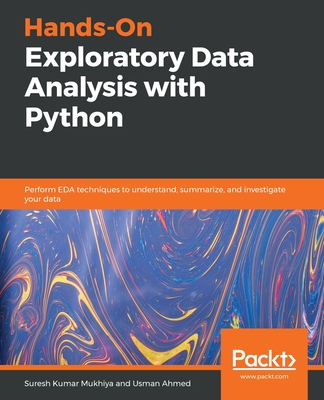Regression Analysis with R: Design and develop statistical nodes to identify unique relationships within data at scale
暫譯: 使用 R 進行迴歸分析:設計與開發統計節點以識別大規模數據中的獨特關係
Giuseppe Ciaburro
- 出版商: Packt Publishing
- 出版日期: 2018-01-31
- 售價: $1,630
- 貴賓價: 9.5 折 $1,549
- 語言: 英文
- 頁數: 422
- 裝訂: Paperback
- ISBN: 178862730X
- ISBN-13: 9781788627306
-
相關分類:
R 語言
海外代購書籍(需單獨結帳)
相關主題
商品描述
Build effective regression models in R to extract valuable insights from real data
Key Features
- Implement different regression analysis techniques to solve common problems in data science - from data exploration to dealing with missing values
- From Simple Linear Regression to Logistic Regression - this book covers all regression techniques and their implementation in R
- A complete guide to building effective regression models in R and interpreting results from them to make valuable predictions
Book Description
Regression analysis is a statistical process which enables prediction of relationships between variables. The predictions are based on the casual effect of one variable upon another. Regression techniques for modeling and analyzing are employed on large set of data in order to reveal hidden relationship among the variables.
This book will give you a rundown explaining what regression analysis is, explaining you the process from scratch. The first few chapters give an understanding of what the different types of learning are - supervised and unsupervised, how these learnings differ from each other. We then move to covering the supervised learning in details covering the various aspects of regression analysis. The outline of chapters are arranged in a way that gives a feel of all the steps covered in a data science process - loading the training dataset, handling missing values, EDA on the dataset, transformations and feature engineering, model building, assessing the model fitting and performance, and finally making predictions on unseen datasets. Each chapter starts with explaining the theoretical concepts and once the reader gets comfortable with the theory, we move to the practical examples to support the understanding. The practical examples are illustrated using R code including the different packages in R such as R Stats, Caret and so on. Each chapter is a mix of theory and practical examples.
By the end of this book you will know all the concepts and pain-points related to regression analysis, and you will be able to implement your learning in your projects.
What you will learn
- Get started with the journey of data science using Simple linear regression
- Deal with interaction, collinearity and other problems using multiple linear regression
- Understand diagnostics and what to do if the assumptions fail with proper analysis
- Load your dataset, treat missing values, and plot relationships with exploratory data analysis
- Develop a perfect model keeping overfitting, under-fitting, and cross-validation into consideration
- Deal with classification problems by applying Logistic regression
- Explore other regression techniques - Decision trees, Bagging, and Boosting techniques
- Learn by getting it all in action with the help of a real world case study.
Who This Book Is For
This book is intended for budding data scientists and data analysts who want to implement regression analysis techniques using R. If you are interested in statistics, data science, machine learning and wants to get an easy introduction to the topic, then this book is what you need! Basic understanding of statistics and math will help you to get the most out of the book. Some programming experience with R will also be helpful
Table of Contents
- Getting Started with Regression
- Basic Concepts - Simple Linear Regression
- More Than Just One Predictor - MLR
- Logistic Regression
- Data preparation
- Avoiding Overfitting Problems - Achieving Generalization
- Going Further with Regression Models
- Beyond Linearity - When Curving Is Much Better
- Regression Analysis in Practice
商品描述(中文翻譯)
**在 R 中建立有效的迴歸模型,以從真實數據中提取有價值的見解**
### 主要特點
- 實施不同的迴歸分析技術,以解決數據科學中的常見問題 - 從數據探索到處理缺失值
- 從簡單線性迴歸到邏輯迴歸 - 本書涵蓋所有迴歸技術及其在 R 中的實現
- 完整指南,教你如何在 R 中建立有效的迴歸模型並解釋結果,以進行有價值的預測
### 書籍描述
迴歸分析是一種統計過程,能夠預測變數之間的關係。這些預測基於一個變數對另一個變數的因果影響。迴歸技術用於建模和分析大量數據,以揭示變數之間的隱藏關係。
本書將為您詳細解釋什麼是迴歸分析,並從頭開始介紹這一過程。前幾章將幫助您理解不同類型的學習 - 監督式學習和非監督式學習,以及這些學習之間的區別。接著,我們將詳細介紹監督式學習,涵蓋迴歸分析的各個方面。章節大綱的安排使讀者能夠感受到數據科學過程中涵蓋的所有步驟 - 載入訓練數據集、處理缺失值、對數據集進行探索性數據分析 (EDA)、轉換和特徵工程、模型建立、評估模型擬合和性能,最後對未見數據集進行預測。每一章都以理論概念的解釋開始,當讀者對理論感到舒適後,我們將轉向實際範例以支持理解。實際範例使用 R 代碼進行說明,包括 R 中的不同套件,如 R Stats、Caret 等。每一章都是理論與實際範例的結合。
在本書結束時,您將了解與迴歸分析相關的所有概念和痛點,並能夠在您的項目中實施所學知識。
### 您將學到什麼
- 使用簡單線性迴歸開始數據科學之旅
- 使用多元線性迴歸處理交互作用、多重共線性和其他問題
- 理解診斷及在假設失敗時應該如何進行適當分析
- 載入數據集、處理缺失值,並通過探索性數據分析繪製關係圖
- 開發完美模型,考慮過擬合、欠擬合和交叉驗證
- 通過應用邏輯迴歸處理分類問題
- 探索其他迴歸技術 - 決策樹、袋裝法和提升技術
- 通過真實案例研究學習,將所有知識付諸實踐。
### 本書適合誰
本書適合希望使用 R 實施迴歸分析技術的初學數據科學家和數據分析師。如果您對統計學、數據科學、機器學習感興趣,並希望輕鬆入門這一主題,那麼這本書正是您所需要的!對統計學和數學的基本理解將幫助您充分利用本書。一些 R 的編程經驗也將有所幫助。
### 目錄
1. 迴歸入門
2. 基本概念 - 簡單線性迴歸
3. 不止一個預測變數 - 多元線性迴歸
4. 邏輯迴歸
5. 數據準備
6. 避免過擬合問題 - 實現泛化
7. 進一步探索迴歸模型
8. 超越線性 - 當曲線更佳時
9. 實踐中的迴歸分析











